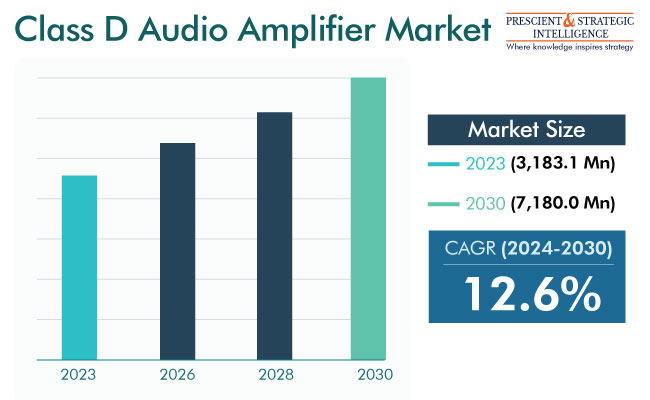Report Code: 10330 | Available Format: PDF
Class D Audio Amplifier Market Revenue Forecast Report: Size, Share, Recent Trends, Strategic Developments, Segmentation Analysis, and Evolving Opportunities, 2024-2030
- Report Code: 10330
- Available Format: PDF
- Report Description
- Table of Contents
- Request Free Sample
Market Overview
The class D audio amplifier market revenue is set to generate USD 3,183.1 million by the end of 2023 and grow at a CAGR of 12.6% between 2024 and 2030, to reach USD 7,180.0 million by 2030.
This is due to the capacity of these devices to transform low-amplitude soundwaves into high-amplitude soundwaves and their high energy efficiency. Additionally, the increasing demand for consumer electronics and the rising demand for high-quality infotainment in vehicles are the key drivers.

Increasing Demand for Smart, Wireless, and Portable Consumer Electronics
One of the major drivers for this market is the increasing usage of class D audio amplifiers in IoT-based consumer electronics, such as smartphones, laptops, TVs, and refrigerators. As per Statista, the global spending on consumer electronics for 2023 is predicted at approximately USD 685.63 billion. The sale of these devices is driven by the tremendous rate of technological developments over the past few years and their continuation with equal fervor, to keep up with the competition.
Thus, the need for class D audio amplifiers is on the rise as wireless headphones, portable speakers, and other mobile accessories become essential components of contemporary lifestyles. These instruments are an appealing alternative to class A amplification techniques since they support the demand for an extended life of the batteries in wireless devices. Additionally, their compact architecture makes it easier to integrate them into small devices without sacrificing audio quality.
Technological Advancements Are Major Trends
The advent of digital signal processing (DSP) and the advancements in the semiconductor technology are the key tends in the market. Class D amplifiers can be produced with improved efficiency, audio quality, and precision because of the ongoing development of semiconductors and DSP algorithms. Audio amplifiers integrated with this technology offer even more benefits, such as a higher efficiency of the amplifier and the audio system.
Modern semiconductor technologies also make it possible to integrate intricate circuitry into a single chip, which lowers the number of components and simplifies the systems. Costs are reduced, dependability rises, and performance, as a whole, is improved. Additionally, these instruments could provide better audio experiences as DSP and semiconductor fabrication techniques develop further.
| Report Attribute | Details |
Market Size in 2023 |
USD 3,183.1 Million |
Revenue Forecast in 2030 |
USD 7,180.0 Million |
Growth Rate |
12.6% CAGR |
Historical Years |
2017-2023 |
Forecast Years |
2024-2030 |
Report Scope |
Market Trends, Drivers, and Restraints; Revenue Estimation and Forecast; Segmentation Analysis; Impact of COVID-19; Companies’ Strategic Developments; Market Share Analysis of Key Players; Company Profiling |
Explore more about this report - Request free sample
APAC Has Largest Market Share
APAC is projected to keep dominating the class D audio amplifier market till 2030. This is because it has countries that manufacture the highest number of automobiles in the world, including Japan, South Korea, China, and India. Most four-wheelers now come with infotainment systems, which offer important driving information and entertainment to passengers via high-quality sound systems, GPS, and other features.
Hence, this industry has been a major driver for the demand for class D audio amplifiers in the Asian region. To offer better-quality audio, advanced amplification solutions are increasingly being adopted. This is a result of the region's increasing technological proficiency and emphasis on innovation.
Further, the demand for consumer electronics and home entertainment systems has increased due to the region's expanding population and rising buying power. Additionally, many government programs are promoting energy efficiency, such as Standards and Labeling by the Bureau of Energy Efficiency (BEE). Its goal is to provide consumers with the information they need to make informed decisions regarding different energy-consuming appliances.
In addition, the Asia-Pacific class D audio amplifier market is growing due to the significant presence of important companies and their partnerships to enhance their product portfolios.

Mono-Channel Type Dominates market
The mono-channel category has the largest share under the type segment, due to the live sound and professional audio industries' growing need for sound reinforcement solutions. These amplifiers cater to the unique needs of large event venues by providing targeted and potent amplification for individual audio sources.
Additionally, the automobile industry's focus on improving in-vehicle audio experiences considerably contributes to the expansion of this category. The need for mono-channel variants is increasing as cars are being outfitted with more-sophisticated systems, which is why they now require specialized amplification for individual audio zones or speakers.
The growth in the usage of mono-channel smart devices, including IoT-enabled products and voice-activated assistants, is another factor supporting this market.
Automotive Sector Has Been a Major Market
The automotive industry is a major user of class D audio amplifiers owing to the continuous evolution in vehicle technologies. For instance, a major current key trend in the automotive industry is the shift toward connected and autonomous vehicles. Additionally, customers are demanding premium music systems in cars.
The demand for superior audio amplification technologies is also being driven by the incorporation of voice assistants and AI capabilities into vehicles. These features create the requirement for crystal-clear, high-quality audio output, which is the key factor behind the market growth.
Class D Audio Amplifiers Major Companies:
- STMicroelectronics N.V
- Texas Instruments Incorporated
- Analog Devices Inc.
- ON Semiconductor Corporation
- Infineon Technologies AG
- Cirrus Logic Inc.
- ROHM Co.
- NXP Semiconductors N.V.
- Monolithic Power system Inc.
- Rensas Electronics Corporation
- Qualcomm Technologies Inc.
Home Audio Systems Are Largest Category by Device
Based on device, the home audio systems dominate the market due to the rising need for high-end audio systems to pair with smart devices. The popularity of smart homes with integrated entertainment systems is growing rapidly. In addition, an increasing focus on individualized audio experiences, such as multi-room audio setups and immersive soundscapes, fuels the demand for excellent and adaptable home audio systems.
Furthermore, the improved wireless technologies allow for easy connectivity, enabling users to play audio material from a variety of devices with ease. Another factor driving the uptake of high-end home audio systems is customers' rising preference for a greater audio quality, which encourages them to purchase high-end audio solutions.
Additionally, customers now view home audio systems as both useful and ornamental items, due to the combination of attractive designs and audio performance. As a result, advanced audio systems that can give rich, dramatic, and immersive experiences are witnessing an increasing demand. This is in line with the growing availability of internet streaming services and content.
By Industry, Consumer Electronics Is Dominant
The consumer electronics division contributes the highest revenue to the market, on the basis of industry. As new technologies emerge, many consumers upgrade their devices to get the latest features. For instance, many people change their earphones, buds, or headphones to get a higher music quality, better wireless connectivity, and additional features. Class D audio amplifiers offer energy and space saving, which makes them ideal for these small devices and high audio quality needs.
Want a report tailored exactly to your business strategy?
Request CustomizationWant an insight-rich discussion with the report author?
Speak to AnalystOur dedication to providing the most-accurate market information has earned us verification by Dun & Bradstreet (D&B). We strive for quality checking of the highest level to enable data-driven decision making for you
Our insights into the minutest levels of the markets, including the latest trends and competitive landscape, give you all the answers you need to take your business to new heights
With 24/7 research support, we ensure that the wheels of your business never stop turning. Don’t let time stand in your way. Get all your queries answered with a simple phone call or email, as and when required
We take a cautious approach to protecting your personal and confidential information. Trust is the strongest bond that connects us and our clients, and trust we build by complying with all international and domestic data protection and privacy laws